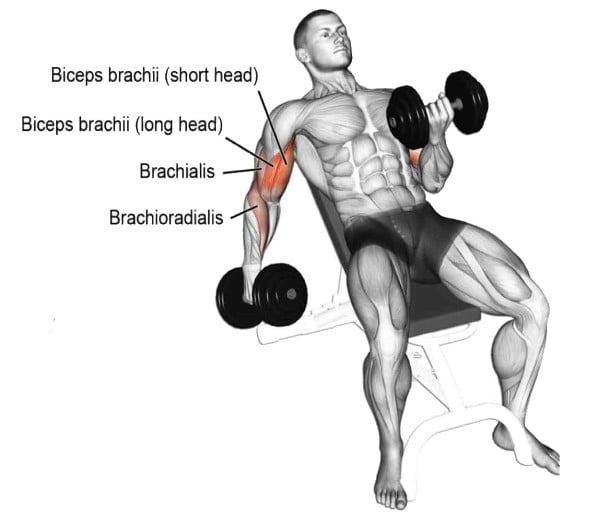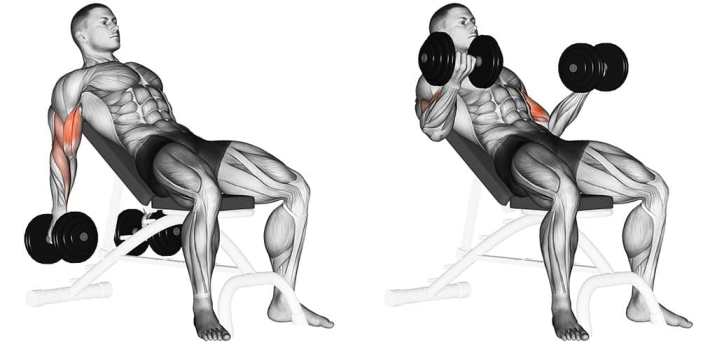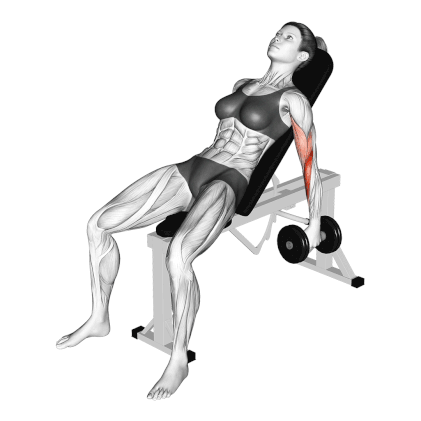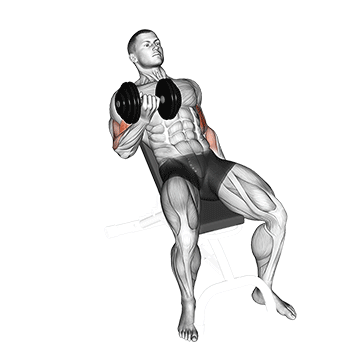Many people focus solely on traditional bicep exercises (barbell curl) for a good reason, but the incline dumbbell curl offers a unique and highly effective way to target your biceps (long head of your bicep).
It is one of the best exercises for building impressive biceps and achieving that coveted gun show-worthy physique.
Incline curls differ from traditional curls due to the incline bench and position of your elbows, which are behind your body and extend your shoulder joint. This unique setup provides several benefits that many other bicep curl variations don’t offer.
- The incline dumbbell curl allows your bicep muscle fibers to experience a deep stretch at the bottom of each repetition.
- This increased stretch leads to a greater range of motion.
- Adding incline curls to your workout routine gives you more variety, refreshes, and prevents plateauing.
The researchers found that the incline dumbbell curl produced the highest EMG activity in the long head of the biceps, followed by the preacher curl and the concentration curl. It also produced the highest EMG activity in the brachialis.

Incline Dumbbell Curl Muscles Worked
The incline dumbbell curl is an isolation exercise that primarily works the biceps brachii. It produces the highest muscle activation in the long head of the biceps and also works the brachialis.
The incline curl involves several synergist and stabilizer muscles, including your forearm muscles, especially the wrist flexors and brachioradialis

How To Do Incline Dumbbell Curl
- Set an incline bench at a 45-degree angle and sit with your back firmly against the bench.
- Grab a pair of dumbbells with a supinated grip (palms facing up) and let them hang at arm’s length by your sides.
- Keep your upper arms stationary throughout the exercise and only move your forearms.
- Slowly lift the dumbbells towards your shoulders, exhaling as you do so.
- Keep your elbows close to your torso and avoid any swinging or jerking motions.
- Once you reach the top of the movement and your biceps are fully contracted, pause briefly to squeeze the muscle.
- Slowly lower the dumbbells back to the starting position. Inhale as you do this.
- Control the entire range of motion and avoid letting the dumbbells drop quickly.
Tips and Form
To get the most out of the incline dumbbell curl and avoid potential injuries, it is important to be aware of common mistakes and how to correct them. Here are some mistakes to watch out for:
- It can be tempting to lift a lot of weight, but using too much weight can worsen your form and increase your risk of injury. It is better to start with a lighter weight and gradually increase it as you get stronger.
- To fully engage your biceps and forearms, perform the exercise slowly and controlled. Avoid swinging or jerking the dumbbells, which can strain your muscles or joints and reduce the exercise’s effectiveness.
- Perform the exercise through a full range of motion. Lower the dumbbells until your arms are fully extended, and lift them until your biceps are fully contracted at the top of the movement.
- When you are sitting on the incline bench, your arms should be in line with your shoulders. If you position your arms too far behind you, you will place an unnecessary burden on your shoulders and increase your likelihood of injury.
- Your upper arm must remain stationary throughout the movement.
- Use supersets or drop sets to increase the intensity of the exercise.
- Incorporate different variations of incline curls to challenge your muscles in new ways.
- Select set, reps, and frequency for incline curl as per your fitness level.
| Level | Sets | Reps | Frequency | Rest |
|---|---|---|---|---|
| Beginner | 2-3 | 8-10 | 1-2 times/week | 60-90 Sec |
| Intermediate | 3-4 | 8-12 | 2-3 times/week | 60-90 Sec |
| Advanced | 4-5 | 10-12 | 2-3 times/week | 60 Sec |

Incline Dumbbell Curl Variations
There are many ways to do incline dumbbell curls to keep your workout routine fresh and challenge your muscles differently. Here are a few popular incline curl variations to build a bigger and stronger bicep.
- Incline Hammer Curl
- Incline Alternating Curl
- Incline Zottman Curl
1. Incline Hammer Curl
Due to the neutral grip, the muscles of the forearm, particularly the brachioradialis, are engaged to a greater extent. This makes the forearm stronger and bigger.
The neutral grip of the incline hammer curl places less stress on the wrists than other curl variations. This makes it a good choice for people with wrist pain or prone to wrist injuries.

How To Do
- Set up an incline bench at a 45-60 degree angle.
- Sit on the bench with your back and your feet flat on the floor.
- Hold a dumbbell in each hand with a hammer grip (palms facing each other).
- Curl the dumbbells up towards your shoulders. Pause briefly at the top of the movement.
- Slowly lower the dumbbells back.
2. Incline Zottman Curl
The incline zottman curl engages multiple muscles in the upper arm, including the biceps brachii, brachialis, and brachioradialis. This leads to a more comprehensive and balanced development of the entire arm.
It uses both supinated and pronated grips to work different parts of your arm.
- A supinated grip works the bicep and brachialis muscles during the concentric phase.
- During the eccentric phase, the pronated grip emphasizes the brachioradialis and forearm muscles, improving forearm size and strength.
How To Do
- Sit on the bench with your back resting against it and your feet planted firmly on the ground.
- Hold a dumbbell in each hand with a supinated grip (palms facing up), arms fully extended, and dumbbells hanging by your sides.
- Exhale and curl the dumbbells toward your shoulder.
- Keep curling until the dumbbells are close to your shoulders.
- Pause briefly at the top of the movement, then rotate your wrists, pronating your grip (palms facing down).
- Slowly lower the dumbbells back to the starting position.
- Once the dumbbells are fully lowered, rotate your wrists back into a supinated grip to begin the next repetition.
3. Alternate Incline Dumbbell Curl
The alternate incline dumbbell curl helps you focus on each arm, correcting any imbalances in strength or size between them.
It improves focus and the mind-muscle connection, which leads to better muscle recruitment and training effectiveness.

How To Do
- Set an incline bench to a comfortable angle, typically around 45 degrees.
- Sit on the bench with your back supported against it, feet firmly planted on the ground.
- Hold a dumbbell in each hand with a supinated grip (palms facing up).
- Curl one dumbbell up towards your shoulder.
- Slowly lower the dumbbell back to the starting position.
- Repeat on the other side. Continue alternating sides for the desired number of repetitions.
References
- Oliveira LF, Matta TT, Alves DS, Garcia MAC, Vieira TMM. Effect of the shoulder position on the biceps brachii EMG in different dumbbell curls. Journal of Sports Science & Medicine. https://pubmed.ncbi.nlm.nih.gov/24150552/
- Barakat C, Barroso R, Alvarez M, Rauch J, Miller N, Bou-Sliman A, De Souza EO. The Effects of Varying Glenohumeral Joint Angle on Acute Volume Load, Muscle Activation, Swelling, and Echo-Intensity on the Biceps Brachii in Resistance-Trained Individuals. Sports (Basel). 2019 Sep 4;7(9):204. doi: 10.3390/sports7090204. PMID: 31487841; PMCID: PMC6783981.

Manish is a NASM-certified fitness and nutrition coach with over 10 years of experience in weight lifting and fat loss fitness coaching. He specializes in gym-based training and has a lot of knowledge about exercise, lifting technique, biomechanics, and more.
Through “Fit Life Regime,” he generously shares the insights he’s gained over a decade in the field. His goal is to equip others with the knowledge to start their own fitness journey.
